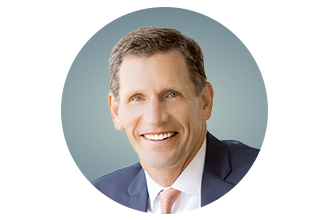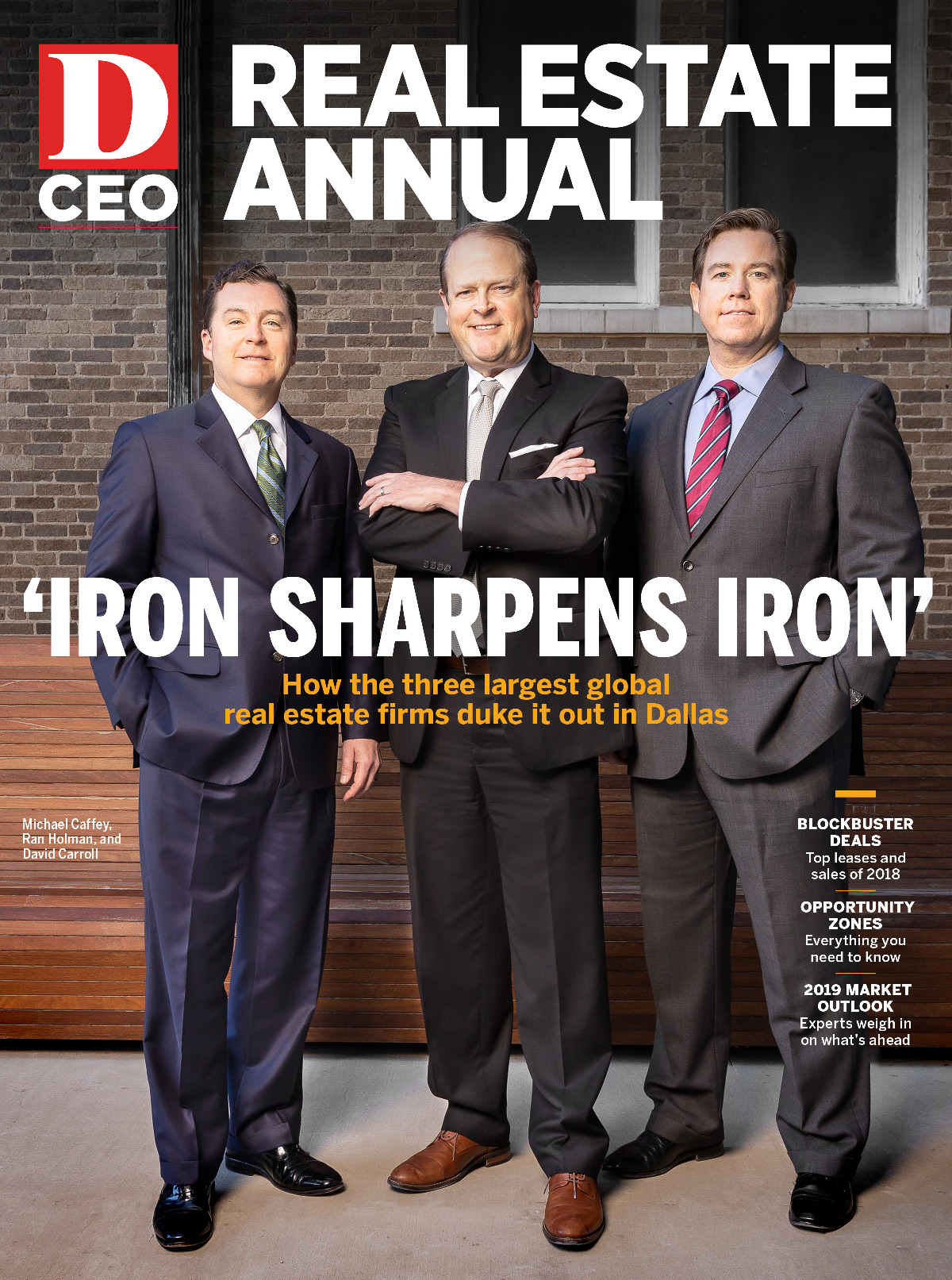We are in unprecedented times, with an up cycle that has lasted well beyond historical norms. But all good things must come to an end. The question is, when will the economy take a downward turn, and how bad will it get? Dallas-Fort Worth is stronger, larger, and more diverse than it has ever been. Companies and people continue to flock here. But even as they’re growing, businesses are leasing smaller offices, going to open-office setups, and trading in space for robust amenities. What does all of this mean for North Texas real estate in 2019? We asked leading office developers and brokers to weigh in.
Susan Arledge
President, Site Selection and Incentives
ESRP
 “The most interesting office market trend I’m seeing is the emergence of remote/virtual workplaces, with co-working concepts opening in all major submarkets. It remains to be seen how remote working will impact the demand for new office space. Market research suggests that it’s probably better to let people work where and when they want. For jobs that mainly require interactions with clients or don’t require much interaction at all, the open office has little to offer besides interruption. But other types of work hinge on collaborative efficiency, or the speed at which a group successfully solves a problem, and distance seems to drag collaborative efficiency down. Collaboration requires communication. And the communications technology offering the fastest, cheapest, and highest-bandwidth connection is—for the moment, anyway—still the office. In 2019, we’ll see more shared office environments, which offer an online environment that is a ‘place’ to go to work with your remote team and clients with live video, screen-share, and other easy-to-use tools.”
“The most interesting office market trend I’m seeing is the emergence of remote/virtual workplaces, with co-working concepts opening in all major submarkets. It remains to be seen how remote working will impact the demand for new office space. Market research suggests that it’s probably better to let people work where and when they want. For jobs that mainly require interactions with clients or don’t require much interaction at all, the open office has little to offer besides interruption. But other types of work hinge on collaborative efficiency, or the speed at which a group successfully solves a problem, and distance seems to drag collaborative efficiency down. Collaboration requires communication. And the communications technology offering the fastest, cheapest, and highest-bandwidth connection is—for the moment, anyway—still the office. In 2019, we’ll see more shared office environments, which offer an online environment that is a ‘place’ to go to work with your remote team and clients with live video, screen-share, and other easy-to-use tools.”
Greg Biggs
Managing Director
JLL
 “The lack of speculative office building is a telling sign that developers and lenders are being very cautious and thoughtful about where we are in this current cycle. This selective development will keep our market from overbuilding. Looking ahead, there will continue to be strong interest in the North Texas region from companies and firms that want to establish a presence here and that are seeking great labor. The biggest challenge will be the increasing cost of new office space, due to increased land and construction costs. Higher operating costs will begin to normalize rental rates, in comparison to other top-tier markets. This will continue to impact how tenants utilize their space. Dallas-Fort Worth has such an amazingly talented group of real estate developers. Watching how the city continues to grow, both in population and square feet, and what we do collectively to accommodate that growth will be an amazing process.”
“The lack of speculative office building is a telling sign that developers and lenders are being very cautious and thoughtful about where we are in this current cycle. This selective development will keep our market from overbuilding. Looking ahead, there will continue to be strong interest in the North Texas region from companies and firms that want to establish a presence here and that are seeking great labor. The biggest challenge will be the increasing cost of new office space, due to increased land and construction costs. Higher operating costs will begin to normalize rental rates, in comparison to other top-tier markets. This will continue to impact how tenants utilize their space. Dallas-Fort Worth has such an amazingly talented group of real estate developers. Watching how the city continues to grow, both in population and square feet, and what we do collectively to accommodate that growth will be an amazing process.”
Susan Blair Cook
Senior Vice President
Avison Young
 “Things have cooled from the highs of 2014-2016, but Dallas-Fort Worth is still a national leader in delivered office space, net absorption, new construction, and corporate migrations. One of the most interesting trends I’m seeing is a scaling down of footprints for office leases. Companies are utilizing more workplace strategy-influenced policies in determining their size requirements, so a company that may previously have taken 10,000 square feet may now only take 8,000 square feet. This creates an interesting challenge for landlords, as they may see consistent deal volume but lower total absorption numbers. I don’t expect this trend to go away, as companies remain frugal. Couple this with the rise of co-working, and landlords will need to be more adaptive and agile to keep revenue streams up and vacancies down. … The flight to quality we’re seeing will continue to put a strain on dated product. Additionally, we currently have the highest amount of vacant sublease inventory since the dot-com bubble burst, a trend that’s worth watching in 2019.”
“Things have cooled from the highs of 2014-2016, but Dallas-Fort Worth is still a national leader in delivered office space, net absorption, new construction, and corporate migrations. One of the most interesting trends I’m seeing is a scaling down of footprints for office leases. Companies are utilizing more workplace strategy-influenced policies in determining their size requirements, so a company that may previously have taken 10,000 square feet may now only take 8,000 square feet. This creates an interesting challenge for landlords, as they may see consistent deal volume but lower total absorption numbers. I don’t expect this trend to go away, as companies remain frugal. Couple this with the rise of co-working, and landlords will need to be more adaptive and agile to keep revenue streams up and vacancies down. … The flight to quality we’re seeing will continue to put a strain on dated product. Additionally, we currently have the highest amount of vacant sublease inventory since the dot-com bubble burst, a trend that’s worth watching in 2019.”
T.D. Briggs
Partner
Peloton Commercial Real Estate
 “Dallas-Fort Worth will end up absorbing around 5 million to 5.5 million square feet of office space in 2018, a phenomenal year that exceeded expectations. Looking at supply and demand, the market has been sitting at approximately 85 percent occupancy for the past five years. With a slowdown in new construction (8.7 million square feet in pipeline) and continued strong absorption, I believe overall occupancy will increase to a historic high of 87 percent to 87.5 percent in the next 18 to 24 months. There are more than 7 million square feet of tenants actively seeking space in the market. The biggest challenge moving forward will be converting yesteryears’ infrastructure (mass transit, roads, retail, community space) to meet today’s demands on a city-wide scale. … Since I got into the business in 1987, DFW has grown from a tertiary, oil-and-gas town with 233 million square feet of office space to a vibrant, diversified, core market, with more than 382 million square feet of office space and endless opportunities to exercise our trade.”
“Dallas-Fort Worth will end up absorbing around 5 million to 5.5 million square feet of office space in 2018, a phenomenal year that exceeded expectations. Looking at supply and demand, the market has been sitting at approximately 85 percent occupancy for the past five years. With a slowdown in new construction (8.7 million square feet in pipeline) and continued strong absorption, I believe overall occupancy will increase to a historic high of 87 percent to 87.5 percent in the next 18 to 24 months. There are more than 7 million square feet of tenants actively seeking space in the market. The biggest challenge moving forward will be converting yesteryears’ infrastructure (mass transit, roads, retail, community space) to meet today’s demands on a city-wide scale. … Since I got into the business in 1987, DFW has grown from a tertiary, oil-and-gas town with 233 million square feet of office space to a vibrant, diversified, core market, with more than 382 million square feet of office space and endless opportunities to exercise our trade.”
Kim Butler
Director of Leasing
HALL Group
 “The North Texas office market met expectations in 2018, although I was surprised by the number of new requirements coming from outside the city, as well as existing tenant expansions as companies bring more of their operations to Dallas-Fort Worth. These weren’t all large deals—we saw a range of sizes—and encompassed many industries, led by tech and healthcare. … The most interesting trend I’m seeing is the flight to quality. This is not a new trend, but it is one that has endured. Although new product is more expensive, space use is changing, so companies are taking fewer square feet per employee. This has resulted in negative absorption in some industries, such as technology, as they have been adding workers but simultaneously downsizing their square-footage. The focus is now on finding the highest quality office space, not necessarily the largest footprint. … Supply and demand remain in check, with a large percentage of new product having some preleasing, which is unusual for Dallas. Overall, the current state of bank financing is keeping developers in check. Looking ahead to 2019, I expect to see ongoing steady demand from small to midsized companies. The heaviest demand we see at HALL Park is for spaces ranging from 10,000 to 20,000 square feet, which has stayed consistent with what we’ve seen the last few years. I also expect lease rates to remain steady. However, as construction pricing continues to increase due to a tight labor market for skilled workers and rising material costs, rates for new product has to be at a premium when compared to existing product. … The biggest challenge the market will face in 2019 is labor. The tight job market is impacting all businesses and industries, and has companies rethinking their real estate as the competition for talent heats up. Dallas-Fort Worth is on the cutting-edge of innovation in both office product and amenities; it’s a market that keeps you on your game. It is exciting to try to anticipate changes and new trends before they happen.”
“The North Texas office market met expectations in 2018, although I was surprised by the number of new requirements coming from outside the city, as well as existing tenant expansions as companies bring more of their operations to Dallas-Fort Worth. These weren’t all large deals—we saw a range of sizes—and encompassed many industries, led by tech and healthcare. … The most interesting trend I’m seeing is the flight to quality. This is not a new trend, but it is one that has endured. Although new product is more expensive, space use is changing, so companies are taking fewer square feet per employee. This has resulted in negative absorption in some industries, such as technology, as they have been adding workers but simultaneously downsizing their square-footage. The focus is now on finding the highest quality office space, not necessarily the largest footprint. … Supply and demand remain in check, with a large percentage of new product having some preleasing, which is unusual for Dallas. Overall, the current state of bank financing is keeping developers in check. Looking ahead to 2019, I expect to see ongoing steady demand from small to midsized companies. The heaviest demand we see at HALL Park is for spaces ranging from 10,000 to 20,000 square feet, which has stayed consistent with what we’ve seen the last few years. I also expect lease rates to remain steady. However, as construction pricing continues to increase due to a tight labor market for skilled workers and rising material costs, rates for new product has to be at a premium when compared to existing product. … The biggest challenge the market will face in 2019 is labor. The tight job market is impacting all businesses and industries, and has companies rethinking their real estate as the competition for talent heats up. Dallas-Fort Worth is on the cutting-edge of innovation in both office product and amenities; it’s a market that keeps you on your game. It is exciting to try to anticipate changes and new trends before they happen.”
Randy Cooper
Vice Chairman
Cushman & Wakefield
 “The market performed with a little less velocity than I was expecting in 2018. There was a lot of good news, but the huge, headline-grabbing deals we have been so accustomed to didn’t come to fruition. … With all the talk about ride sharing and autonomous cars, the fact remains that in Dallas, the majority of corporate transactions involve parking ratios of five to seven spaces per 1,000 square feet of space. That is just the way it is, and I don’t see it changing much in the next five to 10 years. Many landlords will point out that tenants say they need this high ratio but don’t ever utilize it. We have not seen that; we see the appetite for parking growing, not shrinking. … The market seems balanced where there is solid demand: Uptown, Plano, and Las Colinas. In Frisco, where the demand is strongest, supply is lagging. Downtown buildings that were built in the 1980s that have not renovated and added parking will continue to suffer. Looking ahead, ongoing demand for DFW office space will depend on the national economy. It seems that our insulation from broader macroeconomic trends is fading. 2019 should be a good year, but I expect it will lag from the performance we have since the great recovery.”
“The market performed with a little less velocity than I was expecting in 2018. There was a lot of good news, but the huge, headline-grabbing deals we have been so accustomed to didn’t come to fruition. … With all the talk about ride sharing and autonomous cars, the fact remains that in Dallas, the majority of corporate transactions involve parking ratios of five to seven spaces per 1,000 square feet of space. That is just the way it is, and I don’t see it changing much in the next five to 10 years. Many landlords will point out that tenants say they need this high ratio but don’t ever utilize it. We have not seen that; we see the appetite for parking growing, not shrinking. … The market seems balanced where there is solid demand: Uptown, Plano, and Las Colinas. In Frisco, where the demand is strongest, supply is lagging. Downtown buildings that were built in the 1980s that have not renovated and added parking will continue to suffer. Looking ahead, ongoing demand for DFW office space will depend on the national economy. It seems that our insulation from broader macroeconomic trends is fading. 2019 should be a good year, but I expect it will lag from the performance we have since the great recovery.”
Derrick Evers
Managing Partner and CEO
Kaizen Development Partners
 “Dallas-Fort Worth has always been an outlier, relative to conventional wisdom throughout the country. Although we can never take it for granted, we have been blessed with high expectations in our market and, fortunately, they have stayed there. … We think North Texas will see continuing growth in 2019. Many were closely watching the announcement of Amazon. And although the competitor in me wants to win, I’m convinced that Dallas will be a more diverse market because other tremendous users will occupy that void and exceed the ‘fill line.’ … The biggest challenge we’ve seen is answering the question of when the market will turn. It obviously has a ripple effect on the capital stack, users of space, providers of space, and every stakeholder in between. The best analogy I’ve heard is that we could be in the bottom of the eighth inning in a nine-inning game, but it’s likely a double-header.”
“Dallas-Fort Worth has always been an outlier, relative to conventional wisdom throughout the country. Although we can never take it for granted, we have been blessed with high expectations in our market and, fortunately, they have stayed there. … We think North Texas will see continuing growth in 2019. Many were closely watching the announcement of Amazon. And although the competitor in me wants to win, I’m convinced that Dallas will be a more diverse market because other tremendous users will occupy that void and exceed the ‘fill line.’ … The biggest challenge we’ve seen is answering the question of when the market will turn. It obviously has a ripple effect on the capital stack, users of space, providers of space, and every stakeholder in between. The best analogy I’ve heard is that we could be in the bottom of the eighth inning in a nine-inning game, but it’s likely a double-header.”
Duane Henley
Managing Director
Transwestern
 “The majority of tenants I work with are trending to more efficient use of their leased premises, upgrading their office image while reducing the square footage, allowing them to pay a higher rental rate to upgrade. In 2019, tenant demand should remain strong, due to corporate relocations into the region, along with the existing organic growth. I expect rental rates to be flat in 2019, with absorption lower than what we experienced in 2018. … Companies on both coasts have come to the conclusion that doing business in Dallas is extremely cost-efficient, being in the Central Time Zone and providing employees with a more favorable tax environment, affordable housing, and excellent schools for their children.”
“The majority of tenants I work with are trending to more efficient use of their leased premises, upgrading their office image while reducing the square footage, allowing them to pay a higher rental rate to upgrade. In 2019, tenant demand should remain strong, due to corporate relocations into the region, along with the existing organic growth. I expect rental rates to be flat in 2019, with absorption lower than what we experienced in 2018. … Companies on both coasts have come to the conclusion that doing business in Dallas is extremely cost-efficient, being in the Central Time Zone and providing employees with a more favorable tax environment, affordable housing, and excellent schools for their children.”
Sarah Hinkley
Partner
Thirty-Four Commercial
 “We don’t know how much longer this cycle will last, but we do know we are nearing the end. We will see a plateau in lease rates for existing office product and a slight increase in rents for new developments due to increasing construction costs. On average, this will make rates appear to remain flat in the upcoming year. … Dallas tenants are attracted to the newest and brightest product, leaving holes behind in existing product further creating a lack of density. For DFW to become a 24/7 city, we need to make our central business district and core suburban markets walkable. … Looking at the real estate industry itself, there is a huge gap in talent due to the Great Recession and the tech boom in the late 1990s. We are starting to see younger people in decision-making roles and leadership positions. The old ways of getting deals done are shifting to a more fluid model. Technology is advancing our industry in ways we can’t yet see. Our reach is much broader than what it used to be, giving startups and small companies opportunities that didn’t previously exist.”
“We don’t know how much longer this cycle will last, but we do know we are nearing the end. We will see a plateau in lease rates for existing office product and a slight increase in rents for new developments due to increasing construction costs. On average, this will make rates appear to remain flat in the upcoming year. … Dallas tenants are attracted to the newest and brightest product, leaving holes behind in existing product further creating a lack of density. For DFW to become a 24/7 city, we need to make our central business district and core suburban markets walkable. … Looking at the real estate industry itself, there is a huge gap in talent due to the Great Recession and the tech boom in the late 1990s. We are starting to see younger people in decision-making roles and leadership positions. The old ways of getting deals done are shifting to a more fluid model. Technology is advancing our industry in ways we can’t yet see. Our reach is much broader than what it used to be, giving startups and small companies opportunities that didn’t previously exist.”
Robert Jimenez
Senior Director of Leasing
Granite Properties
 “The most interesting trend I see is the shift to flexible leasing (co-working or various short-term options). We will continue to see more co-working locations open up and more landlords getting into this business. Tenants want more lease options than they have had in the past, and I think this flexibility is here to stay. … I believe office supply and demand is in a really good place. There’s 8.7 million square feet under construction, and it’s 68 percent preleased. The new buildings continue to lease up, and we continue to see expansions in our portfolio. There are a few submarkets that could handle more development. Gross rents will continue to increase in 2019, but net rent will level out. Operating expenses and taxes have increased a lot over the last few years, and this will begin to affect a landlord’s ability to increase net rents. … The biggest challenge is everyone trying to figure out where we are in the cycle. Investment sales and development have slowed due to the length of this cycle, but tenants continue to expand and we’re now seeing a lack of good blocks of space in the best submarkets.”
“The most interesting trend I see is the shift to flexible leasing (co-working or various short-term options). We will continue to see more co-working locations open up and more landlords getting into this business. Tenants want more lease options than they have had in the past, and I think this flexibility is here to stay. … I believe office supply and demand is in a really good place. There’s 8.7 million square feet under construction, and it’s 68 percent preleased. The new buildings continue to lease up, and we continue to see expansions in our portfolio. There are a few submarkets that could handle more development. Gross rents will continue to increase in 2019, but net rent will level out. Operating expenses and taxes have increased a lot over the last few years, and this will begin to affect a landlord’s ability to increase net rents. … The biggest challenge is everyone trying to figure out where we are in the cycle. Investment sales and development have slowed due to the length of this cycle, but tenants continue to expand and we’re now seeing a lack of good blocks of space in the best submarkets.”
Allison Johnston
Leasing Agent
Gaedeke Group
 “With the strong economy and spotlight continuing to be on the region, North Texas seems to remain at the top of lists nationally. There is a lot of positive change going on in the region, and this is reflected not only in the development of real estate and job growth, but also in infrastructure, education, and the local culture. … We periodically tour companies looking for unique amenities like pet facilities, meditation rooms, wellness programs, and shuttle services to create the tenant experience within their office community. Quality of life seems to be playing a bigger role in office decisions. … Although office rental rates have increased in the past few years, it seems that rents for the higher-end office assets are leveling out— but certainly not decreasing. I would expect, if anything, that landlords will offer more concessions to keep the rates where they are. You can expect rates to increase in the more dated assets, as they are repurposed to compete with other options in the market. … Looking ahead, I am excited to see how the infrastructure of the city continues to evolve and what impact that has on the region. The expansion of Klyde Warren Park, the addition of the Trinity River Park, and the high-speed rail system are going to change the landscape of the city. I also think the Amazon craze had some companies hesitant to come to the region in fear of competing for talent. We have worked with numerous decision-makers of technology firms who have been cautious to take down too much space or even relocate for that reason. Dallas-Fort Worth now has the largest tech labor force in the South (No. 5 nationally) and continues to provide more opportunities to acquire a technology degree. As jobs continue to grow, I am confident that the talent will continue to follow.”
“With the strong economy and spotlight continuing to be on the region, North Texas seems to remain at the top of lists nationally. There is a lot of positive change going on in the region, and this is reflected not only in the development of real estate and job growth, but also in infrastructure, education, and the local culture. … We periodically tour companies looking for unique amenities like pet facilities, meditation rooms, wellness programs, and shuttle services to create the tenant experience within their office community. Quality of life seems to be playing a bigger role in office decisions. … Although office rental rates have increased in the past few years, it seems that rents for the higher-end office assets are leveling out— but certainly not decreasing. I would expect, if anything, that landlords will offer more concessions to keep the rates where they are. You can expect rates to increase in the more dated assets, as they are repurposed to compete with other options in the market. … Looking ahead, I am excited to see how the infrastructure of the city continues to evolve and what impact that has on the region. The expansion of Klyde Warren Park, the addition of the Trinity River Park, and the high-speed rail system are going to change the landscape of the city. I also think the Amazon craze had some companies hesitant to come to the region in fear of competing for talent. We have worked with numerous decision-makers of technology firms who have been cautious to take down too much space or even relocate for that reason. Dallas-Fort Worth now has the largest tech labor force in the South (No. 5 nationally) and continues to provide more opportunities to acquire a technology degree. As jobs continue to grow, I am confident that the talent will continue to follow.”
Marijke Lantz
Senior Vice President
Billingsley Co.
 “The most exciting trend I’m seeing is the quality and the creativity of product that is being delivered. It’s not just an office building on its own. We are at a juncture where everything needs to work together. Office space is becoming a place to be, rather than just a space within four walls. It is the typical conference centers and workout facilities, but it is also outdoor amenity space and planned social activities. All of this helps tenants in hiring, retaining employees, and boosting productivity. … Tenants are consolidating and moving into newer product across the market. Buildings are starting out as spec buildings and then they are being leased. … DFW should continue to be the beneficiary of the corporate consolidations and relocations due to our strong job and population growth. We are also seeing continued organic growth, with companies needing to expand. Tenant demand continues to go to quality both in product and submarkets. We may see higher vacancy rates in Class B and Class C buildings.”
“The most exciting trend I’m seeing is the quality and the creativity of product that is being delivered. It’s not just an office building on its own. We are at a juncture where everything needs to work together. Office space is becoming a place to be, rather than just a space within four walls. It is the typical conference centers and workout facilities, but it is also outdoor amenity space and planned social activities. All of this helps tenants in hiring, retaining employees, and boosting productivity. … Tenants are consolidating and moving into newer product across the market. Buildings are starting out as spec buildings and then they are being leased. … DFW should continue to be the beneficiary of the corporate consolidations and relocations due to our strong job and population growth. We are also seeing continued organic growth, with companies needing to expand. Tenant demand continues to go to quality both in product and submarkets. We may see higher vacancy rates in Class B and Class C buildings.”
JJ Leonard
Managing Director
Stream Realty Partners
 “Given the amount of leasing activity in the second half of 2017, we anticipated a healthy amount of absorption in 2018, and we have seen just that. We expected rental rate growth to slow some, which has happened and is primarily due to the flight to quality trend we are seeing. We thought we would see vacancy rates continue to level off, which has occurred, and is primarily due to new build-to-suit construction, which has left behind vacant second-generation space throughout the market. This vacancy has offset gains we might have normally seen from such robust absorption. … With unemployment at all-time lows (closing in on 3 percent), companies want to be in high-quality, well-located buildings with both on-site and walkable amenities for employees. HR directors are influencing their companies’ real estate decisions, as the cost for talent far outweighs the cost for real estate. … Looking ahead, I think we will continue to see organic expansion from existing tenants, and I think we will continue to see corporations shifting more jobs, be they back-office jobs or regional growth, to the DFW area. The result should be continued absorption within new and existing product. We also feel that the flight-to-quality trend will continue, as companies have healthier balance sheets and will pay the freight to help attract new talent. … The greatest challenge is probably the state of the capital markets. Building owners in many of DFW’s submarkets want to monetize on the investments they made three to five years ago, but they are having a very hard time selling their properties at a current fair market value. It’s becoming increasingly difficult for new investors, given where most feel we are in the cycle, to underwrite the returns they are seeking for these new investments. We have seen many owners try to sell at reasonable cap rates but be forced to try to refinance when they cannot achieve the numbers they seek. The exception to this is that there are still many investors willing to pay a fair market price for properties in submarkets like Uptown, Preston Center, and Legacy, which offer core or core-plus returns. We will also have to keep an eye on increasing interest rates and inflation, and the ripple effect that may have on the real estate market.”
“Given the amount of leasing activity in the second half of 2017, we anticipated a healthy amount of absorption in 2018, and we have seen just that. We expected rental rate growth to slow some, which has happened and is primarily due to the flight to quality trend we are seeing. We thought we would see vacancy rates continue to level off, which has occurred, and is primarily due to new build-to-suit construction, which has left behind vacant second-generation space throughout the market. This vacancy has offset gains we might have normally seen from such robust absorption. … With unemployment at all-time lows (closing in on 3 percent), companies want to be in high-quality, well-located buildings with both on-site and walkable amenities for employees. HR directors are influencing their companies’ real estate decisions, as the cost for talent far outweighs the cost for real estate. … Looking ahead, I think we will continue to see organic expansion from existing tenants, and I think we will continue to see corporations shifting more jobs, be they back-office jobs or regional growth, to the DFW area. The result should be continued absorption within new and existing product. We also feel that the flight-to-quality trend will continue, as companies have healthier balance sheets and will pay the freight to help attract new talent. … The greatest challenge is probably the state of the capital markets. Building owners in many of DFW’s submarkets want to monetize on the investments they made three to five years ago, but they are having a very hard time selling their properties at a current fair market value. It’s becoming increasingly difficult for new investors, given where most feel we are in the cycle, to underwrite the returns they are seeking for these new investments. We have seen many owners try to sell at reasonable cap rates but be forced to try to refinance when they cannot achieve the numbers they seek. The exception to this is that there are still many investors willing to pay a fair market price for properties in submarkets like Uptown, Preston Center, and Legacy, which offer core or core-plus returns. We will also have to keep an eye on increasing interest rates and inflation, and the ripple effect that may have on the real estate market.”
Frank McCafferty
Executive Managing Director
Savills Studley
 “After years of headline transactions, I was encouraged in 2018 by the velocity of deals in the 10,000- to 30,000-square-foot range. All of us like to hear about and be part of the marquee transactions, but the stability of the market is supported by the smaller and midsize activity. … Although the CBD has large blocks of available space, it is encouraging to see tenants looking at quality options that exist downtown. The activity in Las Colinas since the Toyota Music Factory fully came on line only continues to improve and speaks to the sustainability of this submarket as it is now a true live-work-play community. … Challenges facing the market include transportation, affordable housing, education, and available college-educated millennials for job vacancies. These are serious issues that require serious responses, not happy talk and endless focus groups. … I’m most excited about the sustainability of the market. Dallas-Fort Worth was always boom and bust, but it has matured during this long cycle and is well positioned to weather a downturn.”
“After years of headline transactions, I was encouraged in 2018 by the velocity of deals in the 10,000- to 30,000-square-foot range. All of us like to hear about and be part of the marquee transactions, but the stability of the market is supported by the smaller and midsize activity. … Although the CBD has large blocks of available space, it is encouraging to see tenants looking at quality options that exist downtown. The activity in Las Colinas since the Toyota Music Factory fully came on line only continues to improve and speaks to the sustainability of this submarket as it is now a true live-work-play community. … Challenges facing the market include transportation, affordable housing, education, and available college-educated millennials for job vacancies. These are serious issues that require serious responses, not happy talk and endless focus groups. … I’m most excited about the sustainability of the market. Dallas-Fort Worth was always boom and bust, but it has matured during this long cycle and is well positioned to weather a downturn.”
Bob Mohr
Chairman
Mohr Capital
 “Dallas-Fort Worth is experiencing the best economy and market office growth I have seen in 30 years. From downtown to Legacy, gains were made across the region. … The most interesting trend I’m seeing is consolidation, consolidation, consolidation. More is less, even now with a great economy. … I know everyone is looking for the bubble to burst, but right now the pipeline is full of relocation prospects, coupled with existing users trying to lock in rates today to avoid future increases in lease rates. DFW is still the lowest-cost real estate solution for the 10 major U.S. markets..”
“Dallas-Fort Worth is experiencing the best economy and market office growth I have seen in 30 years. From downtown to Legacy, gains were made across the region. … The most interesting trend I’m seeing is consolidation, consolidation, consolidation. More is less, even now with a great economy. … I know everyone is looking for the bubble to burst, but right now the pipeline is full of relocation prospects, coupled with existing users trying to lock in rates today to avoid future increases in lease rates. DFW is still the lowest-cost real estate solution for the 10 major U.S. markets..”
Dan Paterson
President
Swearingen Realty Group
 “If new investors keep coming into the Dallas-Fort Worth office market and they keep redeveloping properties with significant building upgrades, they will keep trying to push rental rates to a higher amount. As a whole, if things remain status quo on the ownership side, the rise in rental rates should start leveling off. The only exception to this is the Uptown area, which has few remaining sites but ongoing tenant demand. … The biggest challenges facing the market are construction costs and the delay in getting construction permits, and labor availability and costs. All of these were DFW’s biggest assets in the past. Businesses are still attracted to DFW, but costs are coming into play like never before. … I’m relieved that Amazon did not pick Dallas for its HQ2. This will keep the North Texas area more vibrant in the long run, as we will be able to keep the area diversified. Amazon did prove, however, that DFW can compete for any major headquarters operation or relocation on the same level as New York, Los Angeles, or any other major market. The region is even more so in the spotlight for companies that are looking to relocate.”
“If new investors keep coming into the Dallas-Fort Worth office market and they keep redeveloping properties with significant building upgrades, they will keep trying to push rental rates to a higher amount. As a whole, if things remain status quo on the ownership side, the rise in rental rates should start leveling off. The only exception to this is the Uptown area, which has few remaining sites but ongoing tenant demand. … The biggest challenges facing the market are construction costs and the delay in getting construction permits, and labor availability and costs. All of these were DFW’s biggest assets in the past. Businesses are still attracted to DFW, but costs are coming into play like never before. … I’m relieved that Amazon did not pick Dallas for its HQ2. This will keep the North Texas area more vibrant in the long run, as we will be able to keep the area diversified. Amazon did prove, however, that DFW can compete for any major headquarters operation or relocation on the same level as New York, Los Angeles, or any other major market. The region is even more so in the spotlight for companies that are looking to relocate.”
Grant Pruitt
President and Managing Director
Whitebox
 “There are two over-arching drivers in commercial real estate today: HR and risk mitigation. The real estate component is so small compared to the cost of talent, and recruiting and retaining employees. It is the reason that we are seeing the onslaught of co-working and community-centric spaces, urbanization, and blurred lines between live-work-play. The big trends that have resulted are unlimited connectivity, transparency, purposeful environments, personal well-being, and infused technology. The second major driver of real estate decisions in general is risk mitigation. In a post-2008 recession world, risk mitigation is one of the biggest drivers of real estate decisions (avoiding surpluses/shortages and hedging against real estate market swings). Flexibility is crucial to the office users as the majority of companies were caught flatfooted 10 years ago. Most corporate users have come to understand this risk premium in order to achieve the flexibility they need to be nimble and adapt in a rapidly changing future. … In the most recent Beige Book, the Dallas Federal Reserve noted that wage growth due to a tight labor market continues to be an issue for the state, and tariffs and rising interest rates have led to price increases and uncertainty in the markets. Our unemployment rate currently sits at 3.2 percent. That is insanely low, and it has meant that for this quarter we dipped below 300 jobs being created per day for the first time in years. Granted it was only off by two, at 298 jobs per day. It is hard to increase absorption if you can’t continue to hire and grow the workforce. The fundamentals for DFW are great though, and what has offset the strained workforce situation and continues to offset it is the migration to Texas from other states, especially California. Companies want to move to DFW, and that brings more people to the state due to job availability.”
“There are two over-arching drivers in commercial real estate today: HR and risk mitigation. The real estate component is so small compared to the cost of talent, and recruiting and retaining employees. It is the reason that we are seeing the onslaught of co-working and community-centric spaces, urbanization, and blurred lines between live-work-play. The big trends that have resulted are unlimited connectivity, transparency, purposeful environments, personal well-being, and infused technology. The second major driver of real estate decisions in general is risk mitigation. In a post-2008 recession world, risk mitigation is one of the biggest drivers of real estate decisions (avoiding surpluses/shortages and hedging against real estate market swings). Flexibility is crucial to the office users as the majority of companies were caught flatfooted 10 years ago. Most corporate users have come to understand this risk premium in order to achieve the flexibility they need to be nimble and adapt in a rapidly changing future. … In the most recent Beige Book, the Dallas Federal Reserve noted that wage growth due to a tight labor market continues to be an issue for the state, and tariffs and rising interest rates have led to price increases and uncertainty in the markets. Our unemployment rate currently sits at 3.2 percent. That is insanely low, and it has meant that for this quarter we dipped below 300 jobs being created per day for the first time in years. Granted it was only off by two, at 298 jobs per day. It is hard to increase absorption if you can’t continue to hire and grow the workforce. The fundamentals for DFW are great though, and what has offset the strained workforce situation and continues to offset it is the migration to Texas from other states, especially California. Companies want to move to DFW, and that brings more people to the state due to job availability.”
Worthey Wiles
Senior Vice President
Lincoln Property Co.
 “The co-working model has exploded in Dallas over the last couple of years. Venture capital and private equity firms continue to put more and more money into this industry, and corporations continue to appreciate the short-term flexibility this model provides for them. The coworking industry is here to stay and will continue to grow and evolve. … I am excited about the future of Dallas-Fort Worth. The region continues to make all the top 10 lists for its significant employment gains, livability, and strong economy. With our favorable business climate, central location, and affordable housing, people will keep moving here from the coasts and bringing their businesses, too. New office product continues to lease up, and plans are on the drawing board for more mixed-use developments. Corporate relocations and organic growth will keep Dallas on the top of investors’ lists. The future for DFW remains bright!”
“The co-working model has exploded in Dallas over the last couple of years. Venture capital and private equity firms continue to put more and more money into this industry, and corporations continue to appreciate the short-term flexibility this model provides for them. The coworking industry is here to stay and will continue to grow and evolve. … I am excited about the future of Dallas-Fort Worth. The region continues to make all the top 10 lists for its significant employment gains, livability, and strong economy. With our favorable business climate, central location, and affordable housing, people will keep moving here from the coasts and bringing their businesses, too. New office product continues to lease up, and plans are on the drawing board for more mixed-use developments. Corporate relocations and organic growth will keep Dallas on the top of investors’ lists. The future for DFW remains bright!”






